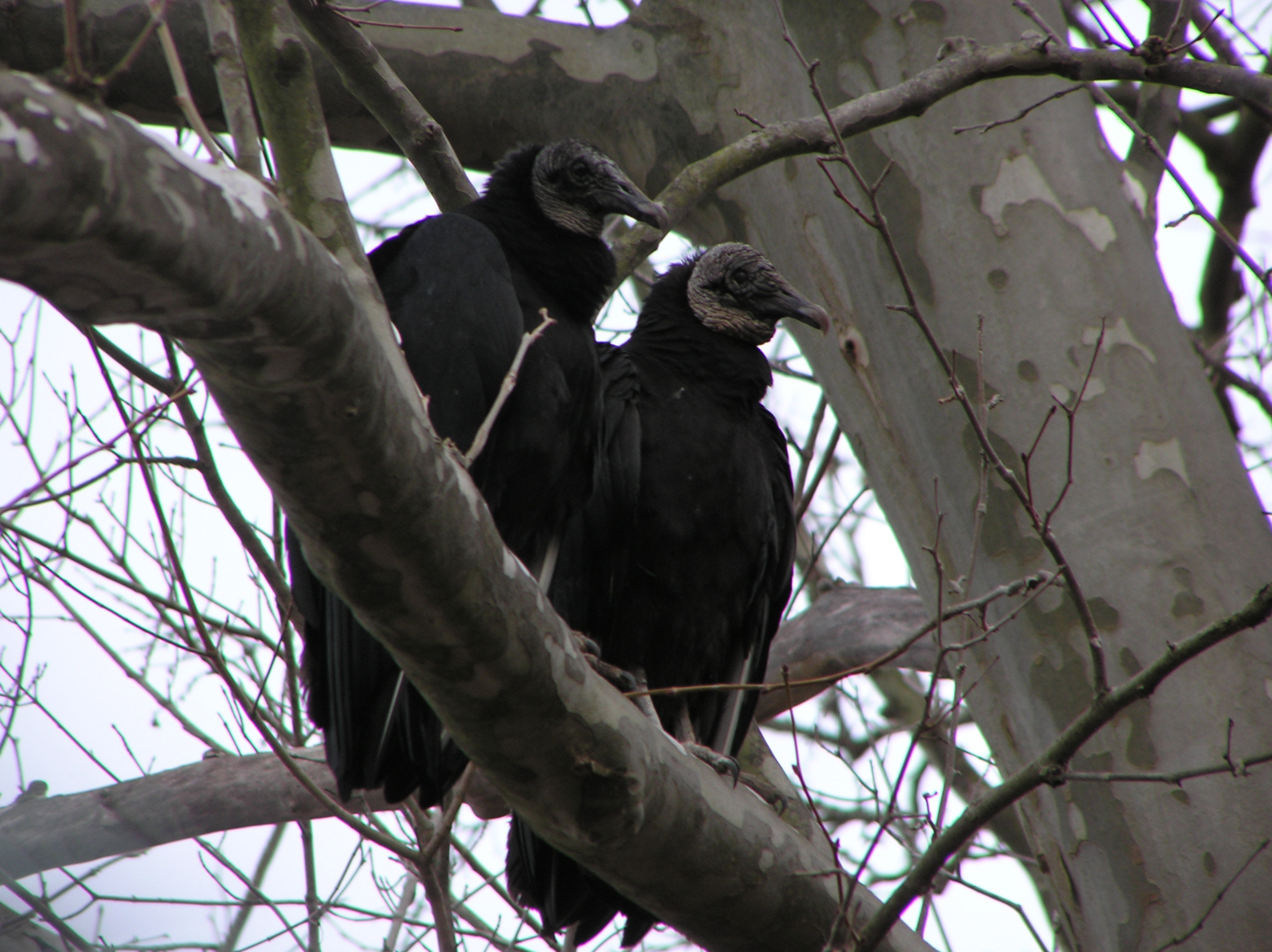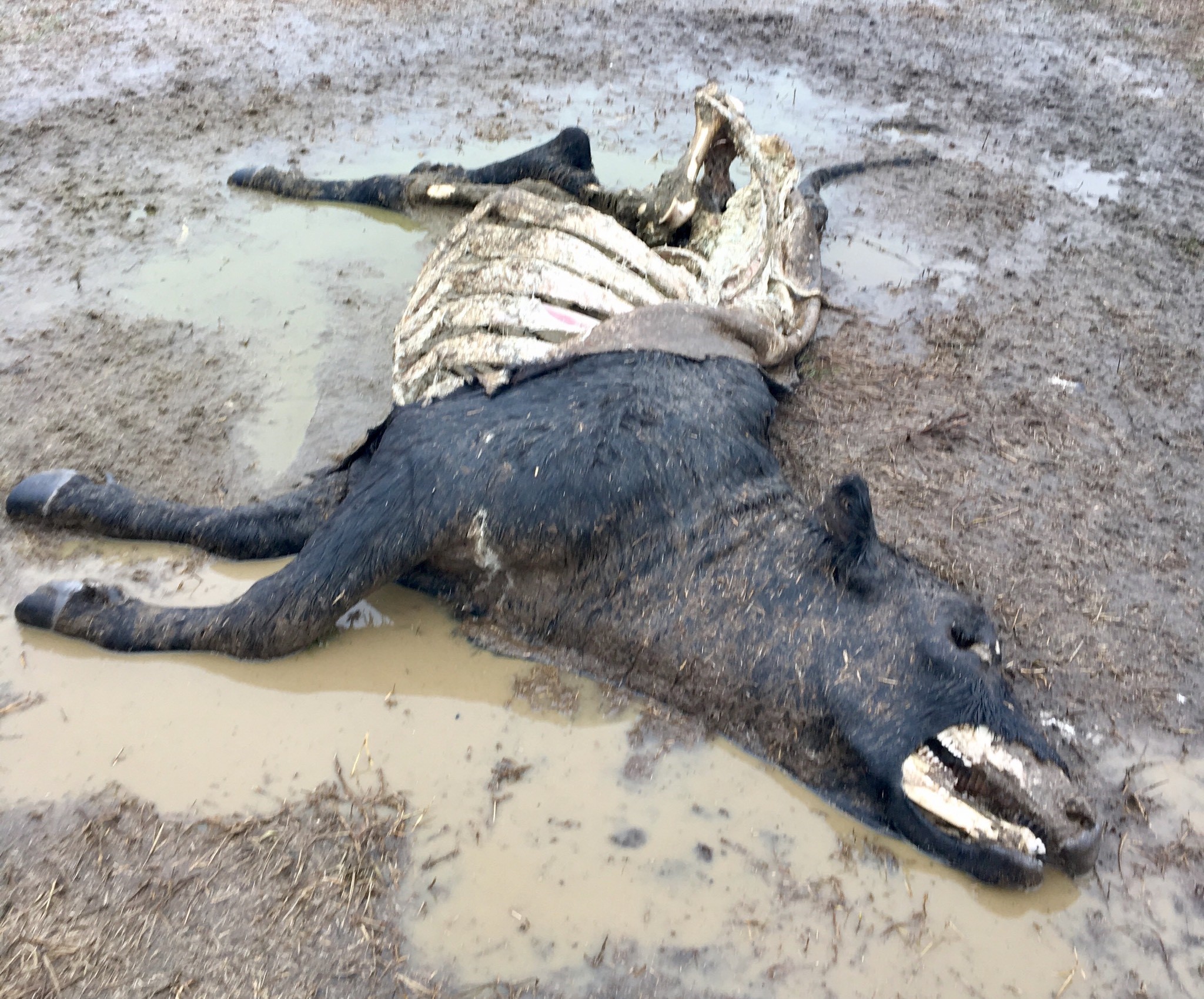Black Vultures in Arkansas

Vultures play a critical role in the environment as scavengers of carrion. Unlike their less-aggressive cousin the turkey vulture, black vultures are known to gang up and prey on living calves, piglets, lambs, and newborn goats. They sometimes attack vulnerable cows while ill or giving birth.
Legally black vultures are protected under the federal Migratory Bird Treaty Act of 1918. Their migratory range extends for thousands of miles from North America to the lower reaches of South America, thus crossing national boundaries. It is illegal to harm, harass, or take (kill) black vultures without a permit.
Black vulture problems
Residential issues. Black vultures sometimes peck and damage rubber seals and windshield wipers on parked vehicles, canvas awnings and seating on boats, and rubber or vinyl materials on rooftops. Property damage and droppings are an issue for some homeowners, while others consider them “peace eagles” and a tourist attraction.
Depredation to livestock. Black vultures leave characteristic evidence of their depredation. The United States Department of Agriculture (USDA) reports black vultures can inflict gruesome damage to livestock. They pluck eyes and eat tongues of newborns, down, or sick livestock; disembowel young livestock; kill and feed on domestic fowl; and leave scars on those animals which survive.
Although black vultures prey on livestock, the actual number of attacks is difficult to determine. It is believed many such incidents go unreported. Sometimes determining whether black vultures are the culprit can be difficult to prove. Stillborns and incapacitated animals are easy prey for a number of predators and scavengers.

Black vultures use visual cues for finding food sources. They drive away predators or scavengers by sheer numbers and an aggressive nature, obscuring what actually caused the animal's demise.
Regardless, the presence of black vultures on farms is an issue for livestock producers. Black vultures are known to take livestock when given the opportunity. The USDA Animal and Plant Health Inspection Service - Wildlife Services is charged with responding to conflicts with migratory species including black vultures.
How to get a permit
Arkansas Farm Bureau. Producers experiencing livestock depredations from black vultures can obtain a permit for taking up to three birds annually from the Arkansas Farm Bureau. Information on how someone can obtain a permit can be found at www.arfb.com/blackvultures.
An additional two birds can be taken upon request. The USDA partnered with the Arkansas Farm Bureau by issuing a limited number of permits for distribution to those experiencing livestock depredation. Certain rules must be followed which include hanging removed birds as effigies.
A document describing guidelines for using effigies to disperse nuisance vulture roosts is available for download. All permittees must report their takes to the Arkansas Farm Bureau. The permit is valid from January - December of the calendar year. No other bird species are authorized to be taken under this program.
USDA APHIS Wildlife Services - Arkansas. Another option is contacting USDA Wildlife Services, particularly those requesting a site visit or a permit to possibly take more than three birds. Contact USDA APHIS Wildlife Services - Arkansas office (501-835-2318) to discuss your problem and/or schedule a site visit for a customized plan from a local biologist. The biologist will provide recommendations and issue a permit application if needed for removal in accordance with state and local laws and ordinances. USDA Wildlife Services then sends the permit application to the U.S. Fish and Wildlife Service's Southeast Region Office in Atlanta, Georgia for approval.
From start to finish, this process can take 2 to 3 weeks, so USDA Wildlife Services should be contacted without delay. The $100 permit is issued for a calendar year from January - December. If lethal removal is deemed necessary, the number of birds permitted for removal depends on several factors including the estimated local population of black vultures.
Non-lethal Options
Frightening vultures
Frightening black vultures using various devices may work in some situations. Protecting larger livestock operations is more difficult where cattle range over large expanses. Around smaller livestock operations, problems with black vultures may be alleviated with constant vigilance and persistent harassment. Loud noises are often used for disturbing and moving black vultures from roosts. Such tactics should be employed before black vultures become established at their roosting site.
Using lasers or pyrotechnics to scare vultures
Black vultures that have been allowed to occupy a roost for an extended time are more difficult to drive away. For established roosts, USDA Wildlife Services recommends using laser pointers or pyrotechnics. Lasers can be a hazard for low flying airplanes, therefore proper authorities should be consulted. Types of pyrotechnics are a starter pistol (like those used in races), shell crackers fired from a 12-gauge shotgun, or propane cannons which periodically emit a loud boom. In urban and some rural locations, nearby residents would need to tolerate loud noises produced by such devices.
Pyrotechnics may disturb livestock especially during the birthing season. Federal, state, county, and local laws should be consulted before using lasers or pyrotechnics.
A federal permit is NOT required for using lasers or pyrotechnics to scare black vultures and other migratory birds in Arkansas. However, federal laws may disallow using lasers near airports and flight paths.
Using vulture replicas as a deterrent
The National Wildlife Research Center recommends frightening black vultures from roosts using fabricated effigies (replicas) of dead black vultures. The Center found fabricated effigies which simply resembled a full-grown vulture -- 25 to 26 inches in length and feathered -- were effective. Preferably multiple vulture effigies should be very visible and hung upside-down by the legs with wings splayed. For additional guidance, see Guidelines for Using Effigies to Disperse Nuisance Vulture Roosts.
Livestock management practices
Livestock producers can discourage black vultures by penning expectant cows, goats, and sheep near human activity. This enables closer scrutiny of an expectant animal and a quicker response to problem situations, thereby improving a young animal's survivability. Some producers have success with livestock guard dogs which can frighten, chase, or attack coyotes, domestic dogs, feral hogs, black vultures, and other potential predators.
Livestock Indemnity Program
When proof of black vulture depredation is obtainable, producers can apply for reimbursement through the Livestock Indemnity Program under the USDA Farm Service Agency (FSA). There must be strong evidence of vulture depredation including authentication by a date-stamped photo or video. Also required is documentation of livestock ownership through purchase or other means. A local FSA committee determines whether there is enough evidence to warrant reimbursement, which can be up to 75% of the average fair market value of livestock lost. For additional information, contact Arkansas FSA at 501-301-3000 or your local USDA Service Center.
Resources
- USDA Animal and Plant Health Inspection Service, Wildlife Services
The mission of USDA APHIS Wildlife Services is to provide Federal leadership and expertise to resolve wildlife conflicts to allow people and wildlife to coexist. Wildlife Services conducts program delivery, research, and other activities through its Regional and State Offices, the National Wildlife Research Center and its Field Stations, as well as through its National Programs.
- Livestock Indemnity Program - Farm Service Agency
This website provides program information for receiving up to 75% reimbursement for animal losses from black vultures and other hazards.
Websites and Publications
- Black Vultures - All About Birds
(Cornell Lab of Ornithology)
Website with identification and life history information.
- Black Vulture Damage Control
(University of Kentucky)
Fact sheet containing information about the biology, habits, signs of depredation, and control options for Kentucky. WARNING - graphic images of depredated animals are presented.
- Use of Vulture Carcasses and Effigies to Reduce Vulture Damage to Property and Agriculture
(USDA APHIS Wildlife Services)
This scientific paper describes several case studies of vulture damage and the effectiveness of using vulture carcasses and effigies to frighten them from roosts.
-
(USDA-APHIS-Wildlife Services - National Wildlife Research Center)These guidelines were developed to assist with the proper placement and display of an effigy to disperse vultures.